|
|
Created/dedicated as per personal communication with Laura Pound, February 3, 2012
Updated as per James P. Tuttle's The Hawk Moths of North America, February 3, 2012
Updated as per BAMONA, February 3, 2012
Updated as per personal communication with Tarah Eastwood, April 11, 2018
|
Mariposa County, California
Sphingidae
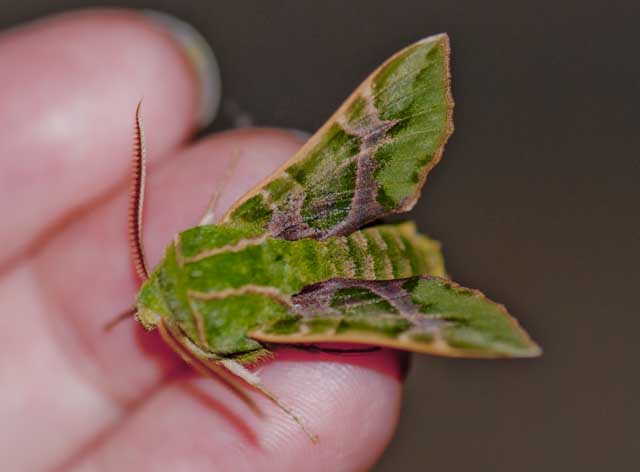
Arctonotus lucidus, Mariposa, Mariposa County, California,
January 29, 2012, courtesy of Laura Pound.
This page is inspired by and dedicated to Laura Pound who provides the Arctonotus lucidus image above, as well as additional images
via link below thumbnail image.
Laura writes, "I took these photos of this beautiful green moth last night, and I found this site while attempting to identify him. He was in the garage, on a
damp towel I needed to launder, so I coaxed him onto my hand and took some photos."
Laura originally submitted some of the images to "What's That Bug" for identification, and Daniel Marlos notified me of the sighting.
Thirty-two Sphingidae species are listed on the BAMONA website for California. Not all of the species are reported by BAMONA for
Mariposa County.
(Ten species: Manduca quinquemaculatus,
Paonias myops,
Smerinthus cerisyi,
Sphinx perelegans,
Sphinx sequoiae,
Arctonotus lucidus,
Eumorpha achemon,
Hemaris thetis,
Hyles lineata, and Proserpinus clarkiae are listed by
BAMONA for Mariposa County.)
It is hoped that this checklist, with the thumbnails and notes, will help you quickly identify the moths you have encountered.
A WO" after the species name indicates that I have no confirmed reports of this species in your county, but I
(William Oehlke) expect that this moth is present.
A green BAMONA indicates the moth is reported on the BAMONA website and/or in Moths of Western
North America, #2. Distribution of Sphingidae of Western North America, revised,
an excellent little booklet available through Paul Opler.
Please help me develop this list with improved, documented accuracy by sending sightings (species, date, location), preferably with an
image, via email to Bill Oehlke.
Please also forward sightings to BAMONA, an excellent online resource.
Many thanks to Tarah Eastwood who provides this nice image of what I believe is a Smerinthus ophthalmica male.
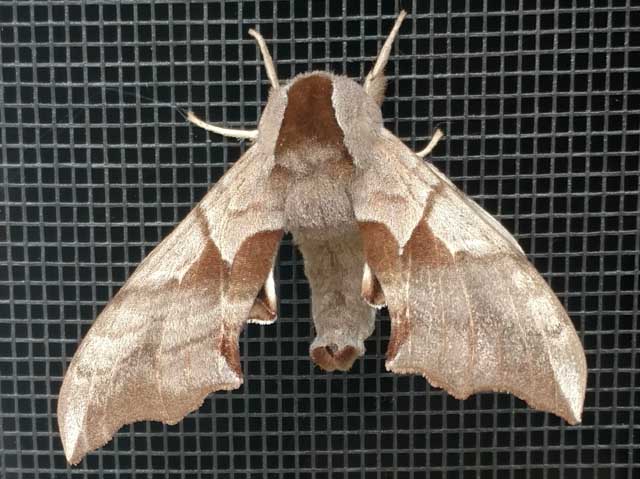
Smerinthus ophthalmica male, Mariposa, 30 miles from Yosemite, Mariposa County, California,
April 11, 2018, courtesy of Tarah Eastwood.
Sphinginae subfamily
Sphingini tribe:
 |
This large bodied moth flies in tobacco fields and vegetable gardens
(potatoes, tomatoes) and wherever host plants are found. |
 |
If you grow tomatoes, you have probably encountered it.
Larvae get very large and can strip a tomato plant. Occasionally they feed on potato foliage and leaves of other plants.
|
 |
Sphinx chersis
WO?, the Northern Ash
Sphinx or Great Ash Sphinx
The upperside of the forewing is soft dark-gray to blue-gray with
a series of black dashes, one reaching the wing tip. Note grey
thorax with narrow black lines.
|
 |
Sphinx drupiferarum,
the Wild Cherry Sphinx, WO ??: FW dull slate grey with considerable light grey scaling in broad band along costa about 3/4 of
distance from body toward apex.
Median lines are black and thin. There is a wavy, diffuse dark subterminal line,
inwardly bordered by white, and whitish bar in terminal area, paralleling outer margin.. (southern range limit in CA)
|
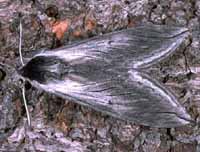 |
Sphinx perelegans
BAMONA, the Elegant Sphinx:
Sphinx perelegans adults fly in montane woodlands and mixed chaparral-type vegetation as a single brood
in the north, with adults mainly on the wing in June and July.
It flies from dusk until after midnight. Note dark thorax.
|
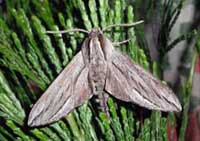 |
Sphinx sequoiae
BAMONA, the Sequoiae Sphinx:
The dark form, occurring from Oregon to central California, has blue-gray forewings with black dashes along the middle. The pale form,
in the juniper belt of the rest of the range, is very pale gray with only a faint blue tint.
Adults fly as a single brood in the desert and in pinyon-juniper
woodland from May to August.
|
Smerinthini Tribe:
 |
This one is quite similar to Pachysphinx modesta, with modesta
being smaller and darker.
Moths should be on the wing from June-August.
|
 |
Paonias myops BAMONA,
the Small-eyed Sphinx
This small species is present in Inyo County. This species ranges across North
America.
The hindwings have a small blue eyespot ringed with black on a yellow
background.
|
 |
Smerinthus cerisyi
BAMONA, the Cerisyi's
Sphinx or One-eyed Sphinx, Larvae feed on poplars and willows.
Flight would be from late May-July as a single brood.
|
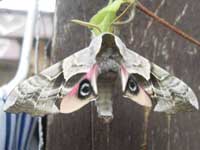 |
Smerinthus ophthalmica
TE, Larvae feed on poplars, aspen and willows.
Note different shape of double arced forewing pm line compared to the straighter pm line of cerisyi, directly above.
S. ophthalmica has smoother scalloping of the fw outer margin.
|
Smerinthus ophthalmica, 30 mile from Yosemite, Mariposa, Mariposa Co.; April 11, 2018, Tarah Eastwood.
Macroglossinae subfamily
Dilophonotini Tribe:
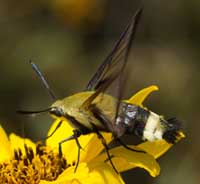 |
Hemaris thetis BAMONA, the Thetis Clearwing or Bee Hawk Moth,
The moth flies along forest edges and in meadows, gardens and
brushy fields. Day-flying adults nectar at lantana, dwarf bush honeysuckle,
snowberry, orange hawkweed, thistles, lilac, Canada violet, etc.
|
Philampelini Tribe:
 |
This moth should be present wherever grapes are found.
Fight would be from June to August. Larvae feed on grape foliage.
|
Macroglossini Tribe:
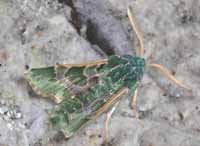 |
Arctonotus lucidus
LP/BAMONA, Pacific Green
Sphinx Moth or Bear Sphinx: Moths have a short, stout body. Forewing upperside is green to olive green with pink and brown markings.
Hindwing upperside is pale rose pink with a darker submarginal band. It tends to be an late winter-early spring flier, on the
wing in the early evening. It comes to lights at night.
|
Arctonotus lucidus, Mariposa, January 29, 2012, Laura Pound
 |
Hyles lineata
BAMONA,
the White-lined Sphinx
Adults usually fly at dusk, during the night, at dawn, and during the
day. Moths nectar at salvia and oviposit on Epilobium cana
(California fuchsia) and Hooker's Evening Primrose in LA county.
|
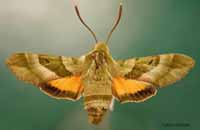 |
Proserpinus clarkiae
BAMONA, Clark's Sphinx:
The upperside of the forewing is greenish gray; the median area may be dark or pale. The upperside of the hindwing is bright orangish yellow with black borders.
Adults fly in the afternoon from April-June in oak woodland and
pine-oak woodland in foothills, nectaring from chia, heartleaf
milkweed, golden currant, bluedicks, fairyfans, vetches,
thistles, hedgenettles, etc.
|
|
|
Enjoy some of nature's wonderments, giant silk moth cocoons.
These cocoons are for sale winter and fall. Beautiful Saturniidae moths will emerge the following spring and summer.
Read Actias luna rearing article. Additional online help available.
Use your browser "Back" button to return to the previous page.
This page is brought to you by Bill Oehlke and the
WLSS. Pages are on space rented from Bizland. If you would like to become a
"Patron of the Sphingidae/Catocala Sites", contact Bill.
Please send sightings/images to Bill. I will do my best to respond to requests for identification help.
 | 
Show appreciation for this site by clicking on flashing butterfly to the left.
The link will take you to a page with links to many insect sites. |


